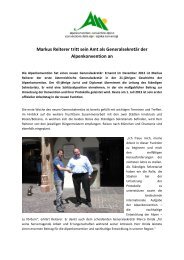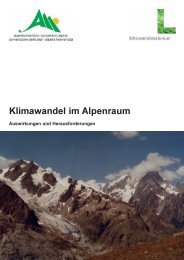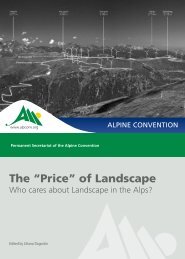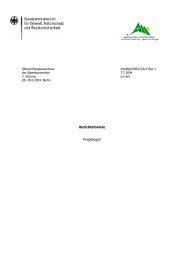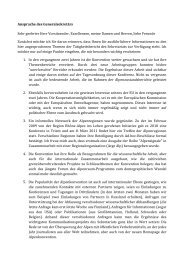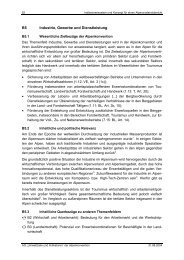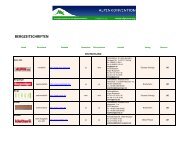Reactivating bed load transport in Swiss rivers Reactivating bed ...
Reactivating bed load transport in Swiss rivers Reactivating bed ...
Reactivating bed load transport in Swiss rivers Reactivating bed ...
You also want an ePaper? Increase the reach of your titles
YUMPU automatically turns print PDFs into web optimized ePapers that Google loves.
<strong>Reactivat<strong>in</strong>g</strong> <strong>bed</strong> <strong>load</strong> <strong>transport</strong> <strong>in</strong><br />
<strong>Swiss</strong> <strong>rivers</strong><br />
Strategic plann<strong>in</strong>g and examples of implmentation<br />
Dr. Lukas Hunz<strong>in</strong>ger<br />
Flussbau AG SAH<br />
dipl. Ing. ETH/SIA flussbau.ch
2<br />
Outl<strong>in</strong>e<br />
� Hystory of the <strong>bed</strong> <strong>load</strong> balance <strong>in</strong> <strong>Swiss</strong> <strong>rivers</strong><br />
� New federal act on the protection of waters<br />
� Strategic plann<strong>in</strong>g<br />
� Alp-Sihl-Limmat: an example
3<br />
Hystory of <strong>bed</strong> <strong>load</strong> balance <strong>in</strong> <strong>Swiss</strong> <strong>rivers</strong><br />
Emme Lützelflüh, 1780
4<br />
Narrow<strong>in</strong>g of river <strong>bed</strong>s
5<br />
Sediment retention <strong>in</strong> the catchment areas
6<br />
Channelised <strong>rivers</strong> suffer from <strong>bed</strong> erosion
7<br />
Bed <strong>load</strong> deficits relative to natural <strong>load</strong><br />
0-20 %<br />
20-50 %<br />
50-80 %<br />
80-100 %<br />
2011
8<br />
New federal act on protection of waters<br />
� Def<strong>in</strong>e the space provided for water courses<br />
� Plan and perform river restorations<br />
� Reduce the harmful effects of hydropeak<strong>in</strong>g<br />
� Reduce the harmful effects of <strong>in</strong>stallations on fish<br />
migration<br />
� Reduce the harmful effects of <strong>in</strong>stallations on the <strong>bed</strong><br />
<strong>load</strong> balance
9<br />
New federal act on protection of waters<br />
� Def<strong>in</strong>e the space provided for water courses<br />
� Plan and perform river restorations<br />
� Prevent the harmful effects of hydropeak<strong>in</strong>g<br />
� Prevent the harmful effects of <strong>in</strong>stallations on fish<br />
migration<br />
� Prevent the harmful effects of <strong>in</strong>stallations on the <strong>bed</strong><br />
<strong>load</strong> balance<br />
‣ To remediate <strong>in</strong>stallations
10<br />
Installations with an an impact on the <strong>bed</strong> <strong>load</strong><br />
balance<br />
� River control prevents<br />
mobilisation
11<br />
Installations with an an impact on the <strong>bed</strong> <strong>load</strong><br />
balance<br />
� Dragg<strong>in</strong>g, gravel traps<br />
and dams prevent <strong>transport</strong>
12<br />
Installations with an an impact on the <strong>bed</strong> <strong>load</strong><br />
balance<br />
� Narrow channels prevent aggradation
13<br />
Reduce Reduce the harmful effects on the <strong>bed</strong> <strong>load</strong><br />
balance<br />
� Targets:<br />
� Indicators:
14<br />
New federal act on protection of waters<br />
� Strategic plann<strong>in</strong>g on cantonal level (until 2014)<br />
� Project plann<strong>in</strong>g, implementation and monitor<strong>in</strong>g by<br />
cantons, municipalities and hydro power companies<br />
(until 2034)<br />
� F<strong>in</strong>ancial contribution<br />
– <strong>Swiss</strong> grid<br />
– Federal subsidies
15<br />
Strategic plann<strong>in</strong>g<br />
� Goal:<br />
– Installations def<strong>in</strong>ed where remediation is mandatory<br />
� Challenges:<br />
– Great number of water courses and <strong>in</strong>stallations<br />
– Timeframe<br />
– Criteria to determ<strong>in</strong>e obligation<br />
– Decentralised competencies
16<br />
Strategic plann<strong>in</strong>g: solutions<br />
� Selection criteria<br />
example Canton Bern:<br />
40 river strechtes<br />
watershed ≥ 100 km 2<br />
Elaboration of<br />
methodology <strong>in</strong> 5 streams
17<br />
Methodology
18<br />
When is the <strong>bed</strong> <strong>load</strong> balance distur<strong>bed</strong>?<br />
Alp - Sihl - Limmat <strong>rivers</strong>
19<br />
Alp - Sihl - Limmat <strong>rivers</strong>
20<br />
Annual <strong>bed</strong> <strong>load</strong><br />
Current stage<br />
Initial stage<br />
Required <strong>bed</strong> <strong>load</strong>
21<br />
Gravel bars at an <strong>in</strong>itial stage (Alp 1890)<br />
Average bar surface: 5'600 m 2<br />
# bar sequences: 2<br />
Mix<strong>in</strong>g layer: 0.3 m<br />
Required <strong>bed</strong> <strong>load</strong>:<br />
5'600 x 2 x 0.3 ≈ 3'400 m 3
22<br />
Gravel bars at an <strong>in</strong>itial stage (Limmat 1850)<br />
Average bar surface: 3'800 m 2<br />
# bar sequences: 1<br />
Mix<strong>in</strong>g layer: 0.3 m<br />
Required <strong>bed</strong> <strong>load</strong>:<br />
3'800 x 1 x 0.3 ≈ 1'200 m 3
23<br />
Measures proposed<br />
� Adjuste managament of gravel traps<br />
� Reduce excavation<br />
� Extract and dump<br />
� Modify weirs<br />
� Lower water level at<br />
weirs dur<strong>in</strong>g floods
24<br />
Dump<strong>in</strong>g of gravel (Limmat 2011)
25<br />
Annual <strong>bed</strong> <strong>load</strong> with measures<br />
Current stage<br />
Initial stage<br />
Bed <strong>load</strong> with<br />
measures
26<br />
Dump<strong>in</strong>g of gravel (Aare 2005)
27<br />
Monitor<strong>in</strong>g the effects of gravel dump<strong>in</strong>g<br />
Extension of gravel bars downstream 1998, 2000, 2006, 2008, 2011
28<br />
Monitor<strong>in</strong>g the effects of gravel dump<strong>in</strong>g<br />
Number of grayl<strong>in</strong>g larvae (Thymallus thymallus) 2005-2009
29<br />
Summary<br />
� Hystory of the <strong>bed</strong> <strong>load</strong> balance <strong>in</strong> <strong>Swiss</strong> <strong>rivers</strong><br />
� New federal act on the protection of waters<br />
� Strategic plann<strong>in</strong>g<br />
� Alp-Sihl-Limmat: an example
30<br />
About the questions<br />
� Policy framework<br />
CH: new act, new funds<br />
� Climate change and sediment <strong>transport</strong><br />
Increased yield <strong>in</strong> upper catchment areas - management<br />
of debris <strong>in</strong> sediment traps<br />
� Knowledge gaps<br />
Gap between hydraulic modell<strong>in</strong>g techniques and empiric<br />
<strong>transport</strong> formulae<br />
� Knowledge on the status on sediment regime<br />
CH: <strong>in</strong> large <strong>rivers</strong> cross sections observed, small streams not
31<br />
About the questions<br />
� Siltation<br />
As widespread as channelised streams with armoured layers<br />
� Artificial floods<br />
Floods to mobilise <strong>bed</strong> <strong>load</strong><br />
Are effects of floods killed by low residual flow?<br />
� Reservoir flush<strong>in</strong>g<br />
Small scale flush<strong>in</strong>gs are widespread<br />
Large scale flush<strong>in</strong>gs (ex. Verbois) are not
32<br />
Thank you







